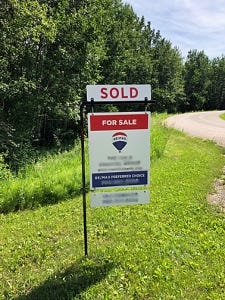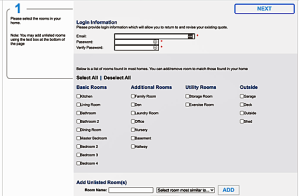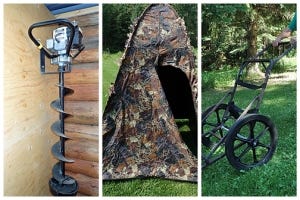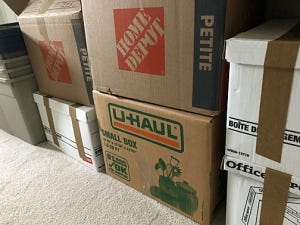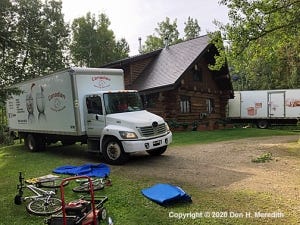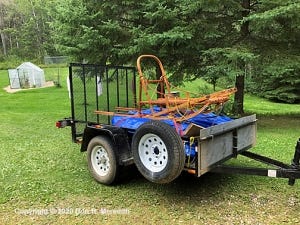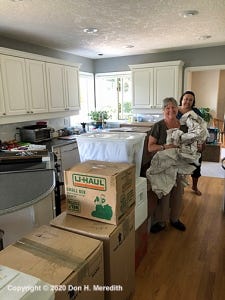Moving in a Pandemic-2
[An Informative Yet Cautionary Tale]
Part 2: Moving
Copyright © 2021 Don H. Meredith, All Rights Reserved
[In Part 1 I discussed how we came to the decision to move from one province to another in the middle of a pandemic and then how we went about selling our old home and buying a new one. In this part, I describe the process we followed to pack our possessions and move to our new home.]
When we finally had selling and buying agreements in hand, the reality of our moving faced us head-on. With about six weeks to pack up our possessions in Alberta and move them across the mountains to Vancouver Island, we had our work cut out for us.
First, we had to decide how we were going to move 50 years of accumulated possessions. We could do the move ourselves, renting a van or truck, or we could hire a company of professionals that could pack and haul most of it for us. Given the quantity of stuff and the time constraints, the latter option seemed the most efficient for us. But whom to hire?
Moving Companies
Like hiring a realtor, hiring a moving company was new to us. When you go online, you see a wide range of companies, some local, some national and some international. Since we had to get our possessions hauled 1200 km over mountains and onto an island via a ferry, we needed a reliable company.
One way to research companies is to look them up online through a search engine like Google. Google does provide a rating service, where customers rate their experiences with the companies. But you have to be careful here, as some of the ratings could be provided by the companies themselves, perhaps through robots. After much searching and evaluating we settled on three companies that had a reasonable track record and good ratings from a large number of people who were obviously not robots.
Because of the pandemic, one company wanted us to first use their online form, where their web program asked questions about the number of rooms in the house and what they contained, etc. The program would then estimate the cost of the move, based on the estimated weight of the total load and where it was going. That exercise was interesting and helped us decide what we should pack and what we should leave for the movers to pack.
The next two companies insisted on sending representatives out to inspect the house and contents first hand. They used the pandemic protocols (masks and distancing) and we learned a lot about how loads are estimated and how to pack things. The more packing into boxes we do, the less cost is charged.
Within a couple of days, we had three estimates to evaluate. But how do you evaluate estimates from three companies who itemize their charges differently? One company might have the cheapest total estimated price but another might have estimated more accurately and so actually has the best deal. So, how do you compare companies?
When it comes to writing up your bill for the move, all companies base it on the total weight of your load (they weigh the loaded van and subtract the weight of the empty van) and the amount of time it took to pack and load the truck. When estimating what that bill might be, they come up with a price/unit of weight and calculate the estimated total cost from that. We told each company the same about what we wanted to pack ourselves and what we wanted the professionals to pack (e.g., furniture, glassware, artwork). So, to my mind the best way to compare them was to divide each company’s estimated total price by their estimated total weight to provide a price/pound for each company.
That resulted in a range of prices. However, price per pound is not the only criteria one should use. What if a company cut its price because it cuts corners when loading or unloading your stuff, or they add extra charges upon arriving at your new home? That’s where the customer reviews come into play. Reading the reviews on a neutral site, such as Google, gives you a general idea of how most people felt about their moves. There will always be people who are not happy but how does that number compare with those who are?
It turned out the company with the lowest price per pound also had 1) the highest number of obvious non-robotic reviews, and 2) the best rating average of all their reviews (4.5 points out of 5). So, we went with that company and booked dates with them for pickup and delivery. Now all we had to do was downsize our load and pack.
Downsizing
Over the years we had accumulated a lot of stuff, some of which we no longer used or needed. Much of it was stored in boxes in our basement and garage and included a lot of memorabilia, either our own or handed down from relatives who had passed on. It all had to be reviewed and decisions made as to their fates: what should go with us, what should be sold, and what should be trashed.
First, we sold to the new owners some yard equipment and tools that more or less went with the Alberta house and property. Then we started sorting out stuff that could be sold at a garage/yard sale: old kitchenware, tents, clothing, hunting and fishing gear, gardening tools, etc.
Garage Sale
At the beginning of the pandemic, garage sales and similar gatherings were prohibited or discouraged. However, we were now on the downside of the first wave, so those restrictions had been relaxed. Betty and I were not big garage sale fans. We had been to very few. But we knew it was a good way to unload items that were no longer of use to us but could be to someone else. Joanne came over the mountains to help us organize such a sale, using her professional event-planning and social-media skills.
Initially, we decided to have a multi-day sale over a weekend and extend it if necessary. Joanne mapped out a display setup that allowed customers to view items, inside and outside the garage, using pandemic protocols. She made a sign explaining how to tour the sale and we setup a table with ample pump bottles of hand sanitizer. We setup other tables in the garage in a horseshoe pattern that facilitated ease of viewing items and physical-distanced moving. Several items were displayed outside to better display their qualities, such as pitched tents and yard equipment.
Promotion: A sale won’t be successful unless people know it’s happening. In the past that would have involved newspaper advertising, numerous signs on the roads leading to your house and word-of-mouth. Of course, that was before the internet and social media. Fewer people read newspapers these days and especially classified ads. Instead, as we learned from our daughter, most prospective customers follow social media, either Facebook, Instagram, Twitter or all of them. Signs on roads and streets also help. As we soon learned, a lot of people, many who don’t use social media, cruise highways in search of garage sales, especially on weekends. Word of mouth also works, but that is facilitated these days by email and yes, social media.
Many older websites such as bulletin boards and forums (precursors to social media) also used to be good places to sell stuff. I use and at one time helped manage a popular online forum for Alberta hunters and anglers. It had been a good site to sell outdoor gear. So, I announced the garage sale on its buy-and-sell pages, including listing specific outdoor items. I received no productive responses, whatsoever. When we advertised the same items on the various social media sites (e.g., Facebook’s local Marketplace pages), we got instant responses; and people came from near and far to buy many quality items.
Sale: We started the sale on a Friday and continued it through the weekend. It was everyone on deck for those three days with help from some of Joanne’s friends. We advertised the sale would be from 10 a.m. to 4 p.m. but we often stayed open past dinner as people kept arriving, and we weren’t going to turn them away. As well, we usually started setting up each morning at 8:30 or 9:00 and people would show up then to get a jump on things. We didn’t turn them away either. You never know who might buy that item others have passed.
Most sales were in cash, and we made sure we had enough on hand to make change, etc. One person was given responsibility for keeping the cash purse for the day. Some sales of more expensive items were made using e-transfer, which was easy and fast on our mobile phones. As things sold or prices were lowered, Joanne would update the marketplace websites on her phone.
We sold a good amount of goods over the weekend but we still had a lot to go (and were finding more as we packed). So, we extended the sale into the following week. Traffic during the week wasn’t as much as on the weekend but it was constant. While we packed, one person kept an eye on the sale.
The people who came to the sale were from a wide variety of backgrounds. Most were looking for bargains and we tried to supply just that. Haggling was expected. Although we had prices taped to the items, they often were the starting points for negotiation. Other people just paid what we asked. Some people offered way below what we were asking and we asked them, in a polite way, to come back with a serious offer. Our purpose was to move items rather than make a lot of money. But we also wanted fair compensation for the value of what we were offering. As a result, there were some interesting negotiations.
One immigrant family showed up on the first weekend and bought a lot of household stuff, from kitchenware to pillows and blankets. They had just moved from Quebec for the father to take an engineering job in Edmonton. They were living in an apartment without furnishings. When we helped them load their purchases in their older model SUV, it was already packed with items purchased at other garage sales. They were good bargainers, especially the mother.
However, the most endearing part of the family was their daughter who took a liking to Joanne’s teddy bear collection in a large, clear plastic bag. We had been keeping the bears for Joanne long after she stopped collecting them, but she knew she had no space for them all in our new home. She reluctantly put them in the sale, but set the bag back from the main tables. The little girl twigged to them instantly and wanted to get to the largest one, a pure white polar bear that was bigger than she was. Joanne saw her interest and helped her pull the bear out of the bag. Within minutes, the girl was dragging it to her daddy, pleading to please buy it for her. He winked at us and told her he would have to wait and see what the girl’s mother was buying before deciding to buy the bears. (He was also bargaining with me over an old, still functioning, stereo system.)
The little girl went back to the teddy bear bag and pulled out another large bear and two smaller polar bears. When the family finally had what they wanted in a big pile (Betty had been tallying each of the items), they of course wanted a bargain price for the whole lot. That is when the daughter appeared with the four bears: the poppa, momma and two baby bears. She argued that she needed all four bears because they were a family and shouldn’t be broken up. I looked at Joanne, whom I knew had a big attachment to those bears, and I could tell she was pleased with the girl’s passion for them, similar to hers when she was the girl’s age. When the father asked “How much for the bears?”, Joanne offered a price that was well below what they were worth. The father accepted and the little girl was jubilant, hugging her father and then Joanne. It was a special moment for everyone and hard to hold back a tear.
Packing
Let’s face it, packing is not fun. But it’s a job that must be done. We generally worked all day, every day, organizing, sorting and putting things into boxes.
Tips
There are a lot of resources available to help you pack. Often your moving company (if you’re using one) will have such things as boxes and tape available for sale. But there are often better deals elsewhere.
For example, your local U-Haul franchise should have a variety of packing boxes for sale. Their boxes are very good, in various sizes and have a unique way of keeping the box flaps out of the way until you need to seal the box. Their packing tape is the best on the market. Buy several rolls, as you will use a lot. You can return any unused boxes for a refund.
As well, Home Depot has a wide selection of packing boxes and items for sale at slightly lower prices than U-Haul, but quality varies.
Don’t pack boxes for hauling smaller than 12 x 12 x 12 inches. If you’ve stored things in shoeboxes, put the shoeboxes into a larger box. Movers like to reduce the number of trips they have to make from the house to the moving truck.
Rule of thumb: the heavier the object, the smaller the box it should fit. In other words, don’t fill a large packing box with books or other heavy objects. Use smaller boxes to reduce the weight per box. Save the larger boxes for lighter objects that can be packed together. Overweight boxes are hard for movers to handle and might not survive the trip. If movers encounter an overweight box, they just might spend time repacking into smaller boxes, increasing your cost. Here are some examples of how to pack boxes:
Small boxes: books, contents of filing cabinets, unframed photo collections, heavy tools (e.g., circular saws, power drills, routers, compressors)
Medium boxes: stereo/sound equipment, computers, televisions, kitchenware
Large boxes: artwork, posters, framed photos, contents of desks, miscellaneous nick-nacks you just can’t live without
If you have large equipment (e.g., fitness equipment, table saw) that would require several people to move, disassemble it into more easily moved pieces if that is possible. This will make moving easier. If you don’t disassemble it, the movers might.
Furniture might also require disassembly. But often it’s difficult to determine what can be disassembled and what cannot. We decided to leave that to the movers who have such experience.
Moving Day
We packed right up to the day the movers arrived. They were to arrive around 8:30 a.m. I was up early and outside, getting things ready to go like bicycles and yard equipment. The movers started showing up around 8:00 in private vehicles. They were contractors hired by the company for the day to help with loading the trucks. All were young guys and very affable, asking where we were going and how they could help me get things ready.
Soon two moving vans showed up with the company’s crew, who didn’t waste any time. They backed each truck to our doors, one to the front and one to the back. They brought two smaller vans because the larger (53 foot) van that would make the trip over the mountains could not negotiate or S-curve driveway. The larger van would be loaded in Edmonton.
I took the crew leaders on a tour of the house, garage and sheds, so they could plan the loading and see what needed to be packed. They appreciated we had a lot of stuff already boxed and ready to go.
The crew was very professional and efficient. As soon as the trucks parked by the house, ramps appeared so that stuff could be loaded directly from the door to the van without having to go down the stairs. Some of the crew started immediately moving the boxes we had packed and sealed, while others started disassembling furniture and packing the glassware in our kitchen.
It was interesting to watch the movers work. Instead of carrying boxes in their hands ahead of their bellies, they took a stack of the same size boxes on their hands behind their backs. When I asked why, they said it was easier on the back because the boxes were closer to the centre of gravity (as modern backpacks are designed). They also used belts and straps to haul larger, heavier loads. None-the-less, it was definitely a job for a younger person than me.
While the movers worked, I loaded our utility trailer with many of the heavier tools, such as chainsaw, compressor, axes, mauls and other tools we might need at the new house before the movers arrive. One item I didn’t know what to do with was the old hand-made sled from our dog sledding years back in the late 1970s and ‘80s. It wasn’t in the best condition but I thought a committed dog driver could recondition it and suggested we sell it in the garage sale. Joanne said no way. She had too many memories attached to that sled (as did I) and said we were hauling it to the new home where she would figure how to make it into some form of artwork that would remind of us of those dog-sledding days. So, we tied the sled to the top of the load on the trailer.
Before we knew it, the movers had everything loaded by noon. The boss took Betty and me on a tour of the house, garage and sheds to ensure all was loaded that needed to be loaded. Once we confirmed that was true, everyone said goodbye and the two vans and movers left, the boss saying he would see us on the island.
Betty, Joanne and I stood outside the now empty house, watching the vans drive away. We looked at each other and realized we no longer had a place to live. There were no beds or furniture we could use, and the fridge was empty. Fortunately, our good friend and neighbor, Helen, said we could stay at her place for the night. She treated us to a good dinner and breakfast, after which we said goodbye, returned to our sold house for a final inspection and clean-up, and left in three vehicles for our new home.
We really had no plan other than to drive to Harrison Hot Springs by the following day to stay with our friends there before moving on to the island. It was a beautiful day and we just kept driving, getting to Harrison in 12 hours.
We took possession of our new home on Vancouver Island a few days later. It was the first time Betty and I had seen the place in reality, and it did not disappoint.
The movers came a few days after that with their 53-foot van. Our possessions only took up ½ of the load. They also moved a family from Edmonton to Vancouver in the same load. As with the loading, the movers hired some local contractors to help with the unloading and moving into the house. We had labeled each box with the room in which it should be placed, which speeded the efficiency of the process. One or two of us stood outside and guided unlabeled items to their respective places.
They unloaded all our possessions and moved them inside our house in just a few hours. At the end, the boss took me on a tour of the empty van to confirm all had been unloaded. I agreed, and we all bid the movers goodbye. We were moved in. Now all we had to do was unpack.
Bitter/Sweet
For Betty and I, the move was indeed bitter/sweet. We had spent 50 years in Alberta, 42 in the log home we built in Parkland County. We have many good friends and many great memories in Alberta, from building our own home to all the gardening, hiking, hunting, fishing and exploring we did in the variety of landscapes that is Alberta. It was hard to leave all that behind. But we realized that taking care of a country home with a large woodlot and garden was becoming more and more difficult for us. It was inevitable we would have to move sooner or later.
On the other hand, we always enjoyed our trips to British Columbia, its many mountain ranges, rivers, lakes, parks and great fishing. So, it was easy to look forward to our new adventure, while using the time afforded by the pandemic to make a positive difference in our lives.
We are enjoying our new home where we can share experiences, triumphs and trials with Joanne and Ian. Of course, such a move is not for everyone. Ours was planned and executed on the special circumstances we faced as an extended family. Besides the hard work and frustrations, we also had a bit of luck along the way, as we made our move between what turned out to be the first and second waves of the pandemic. The help and advice of friends and professionals also were key to our success. I wrote this piece in the hope it might help others make decisions about where they want to go beyond the pandemic.
Good luck to all and Stay Safe!
Comments are always welcome (below).
Visit me on my website where you’ll find more stories and pics:
www.donmeredith.ca
Interested in reading an award-winning outdoor adventure novel? Check out The Search for Grizzly One and Dog Runner.


